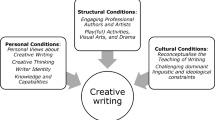Abstract
This review explores Alfred Schademan’s “What does playing cards have to do with science? A resource-rich view of African American young men” by examining how he uses two key concepts—hybridity and resources—to propose an approach to science education that counters enduring deficit notions associated with this population. Our response to Schademan’s work expands upon his definition of hybridity and its purpose in the science classroom and highlights the tensions inherent in the appropriation of student resources in classroom spaces. This conversation points also to the need for research analyses and pedagogical approaches that simultaneously valorize student resources, allow student opportunities to learn the dominant codes, and provide teacher and student opportunities to transform them. Carol Lee’s notion of “cultural modeling” is discussed as a possible framing device to facilitate this kind of research.
Similar content being viewed by others
References
Barton, A. C. (1998). Reframing “science for all” through the politics of poverty. Educational Policy, 12, 525–541.
Bhabha, H. K. (1994). The location of culture. New York: Routledge.
Boykin, A. W. (1986). The triple quandary and the schooling of Afro–American children. In U. Neisser (Ed.), The school achievement of minority children: New perspectives (pp. 57–92). Hillsdale, NJ: Lawrence Erlbaum Associates.
Elmesky, R., & Tobin, K. (2005). Expanding our understandings of urban science education by expanding the roles of students as researchers. Journal of Research in Science Teaching, 42, 807–828.
Emdin, C. (2010). Science education for the hip-hop generation. Rotterdam: Sense Publishers.
Gutierrez, K., Morales, P., & Martinez, D. (2009). Re-mediating literacy: Culture, difference, and learning for students from nondominant communities. Review of Educational Research, 33, 212–245.
Gutierrez, K., & Rogoff, B. (2003). Cultural ways of learning: Individual traits or repertoires of practice. Educational Researcher, 32, 19–25.
Lee, C. (1992). Literacy, cultural diversity, and instruction. Education and Urban Society, 24, 279–291.
Lee, C. (2001). Is October Brown Chinese? A cultural modeling activity system for underachieving students. American Educational Research Journal, 38, 97–141.
Lee, C. (2009). Historical evolution of risk and equity: Interdisciplinary issues and critiques. Review of Research in Education, 33, 63–100.
Lee, L., & Anderson, K. (2009). Negotiating linguistic and cultural identities: Theorizing and constructing opportunities and risks in education. Review of Education Research, 33, 181–211.
Lorde, A. (1984). Sister outsider. Berkeley: Crossing Press.
Richardson Bruna, K. (2008). Jesús and María in the jungle: An essay on possibility and constraint in the third-shift third space. Cultural Studies of Science Education, 4, 221–237.
Seiler, G., & Elmesky, R. (2007). The role of communal practices in the generation of capital and emotional energy among urban African American students in science classrooms. Teachers College Record, 109, 391–419.
Seiler, G., & Gonsalves, A. (2010). Student-powered science: Science education for and by African American students. Equity & Excellence in Education, 43, 88–104.
Sewell, W. H. (1992). A theory of structure: Duality, agency, and transformation. American Journal of Sociology, 98, 1–29.
Swanson, D. P., Cunningham, M., & Spencer, M. B. (2003). Black males’ structural conditions, achievement patterns, normative needs, and “opportunities”. Urban Education, 38, 608–633.
Author information
Authors and Affiliations
Corresponding author
Additional information
Forum response to Schademan, A. (2010). What does playing cards have to do with science? A resource-rich view of African American young men. Cultural Studies of Science Education. DOI 10.1007/s11422-010-9275-5.
Rights and permissions
About this article
Cite this article
Gonsalves, A.J., Seiler, G. & Salter, D.E. Rethinking resources and hybridity. Cult Stud of Sci Educ 6, 389–399 (2011). https://doi.org/10.1007/s11422-010-9295-1
Received:
Accepted:
Published:
Issue Date:
DOI: https://doi.org/10.1007/s11422-010-9295-1



